Anolis chrysolepis
This species, native to Trinidad, has a red dewlap below the
throat, extended as a signal to other lizards. Other species of Anolis
in Trinidad and Tobago have a yellow or greenish dewlap, and a longer snout.
A. chrysolepis is a rarely-seen inhabitant of forests.
| 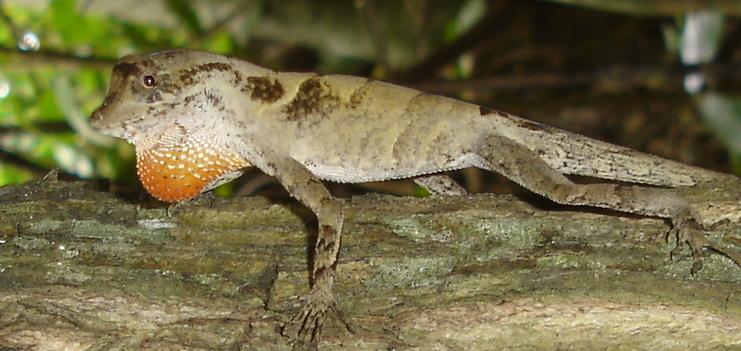 |
Male Anolis wattsi
Native to Antigua, this is the only species
in Trinidad and Tobago in which the sexes are of very different appearance. Males
are orange with bright blue on the head, and females (below) are brown with pale
stripes along the sides and the centre of the back.
| 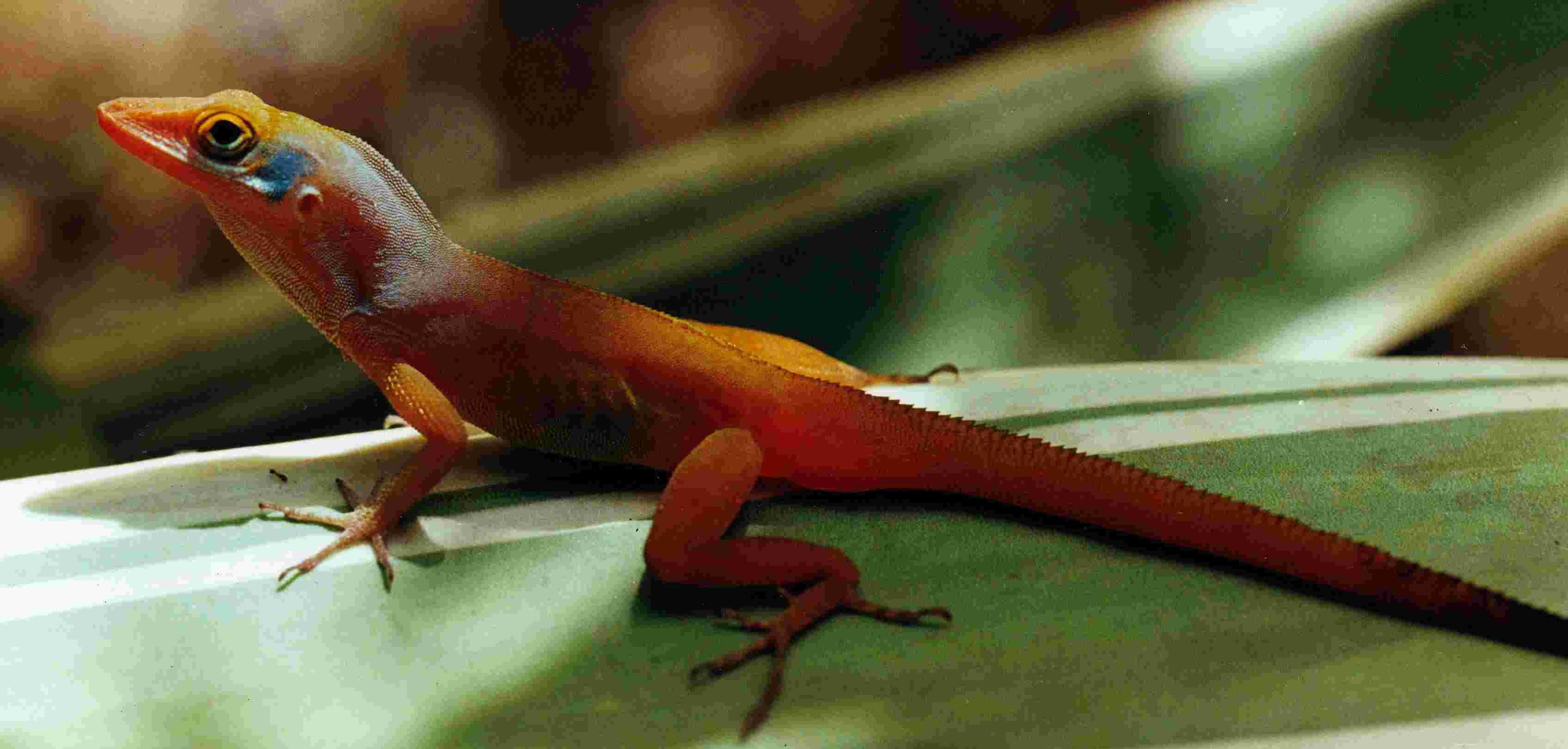 |
Female Anolis wattsi
This species spends about a third of the time on the ground, the rest climbing
on trees, bushes, walls and fences. Other species of Anolis introduced to
Trinidad and Tobago spend less than 5% of their time on the ground.
|  |
Anolis aeneus sleeping
A brown lizard with dark spots or cross bars, native to Grenada. Anolis
lizards sleep at night, usually holding on to a leaf at the end of a branch where
they cannot be reached by predators. This one is on a window bar.
| 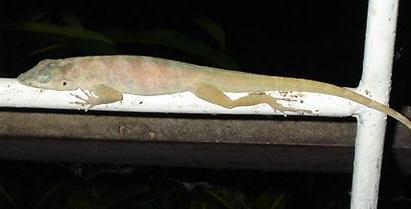 |
Anolis trinitatis
This species was first scientifically described in 1863 using specimens from Trinidad.
Only later was it found to be introduced here, and really native to St.
Vincent, but by the rules the original name "trinitatis" has to remain.
| 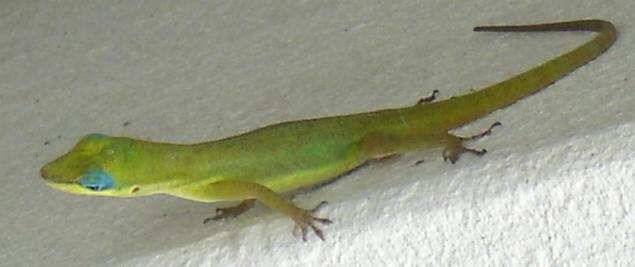 |
Male Anolis trinitatis
Both sexes are bright green with blue around the eye, and males often have pale blue heads.
| 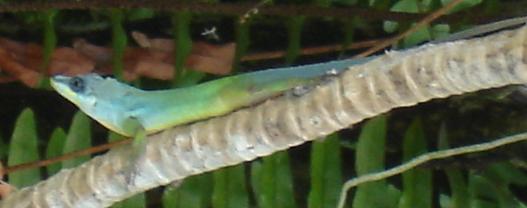 |
Anolis richardii
A larger lizard than the other Anolis species, growing to 34 cm (13 inches), it is
also the only species on Tobago where it was introduced from Grenada. Colour ranges from
grey to brown and dark green, with a yellow dewlap. Females and young often have a
yellow or cream side stripe.
| 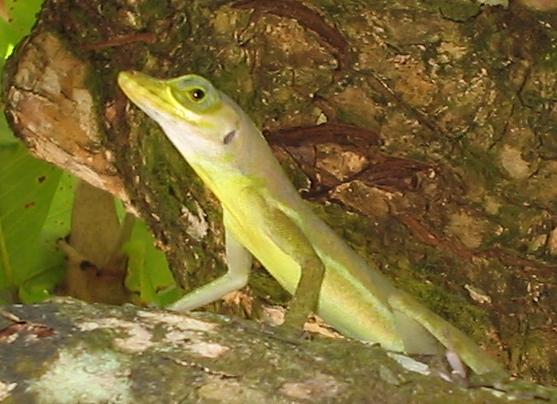 |
Introduced lizards in Trinidad and Tobago (from "UWI Today")
The small lizards of the genus Anolis are perhaps the most characteristic animals of
the West Indies, typically seen perching head-down on tree trunks. There are no generally
accepted common names for these lizards in Trinidad and Tobago; they are not closely related to
the ‘zandolie’ or common ground lizard (Ameiva ameiva). Worldwide there are about 300
species of Anolis, about half of them in the West Indies, the other half in Central and
South America. Most small Caribbean islands have one or two species, increasing on larger
islands. Jamaica has 7 species, and Cuba and Hispaniola have more than 35 species each.
Population densities are greatest in the West Indies, reaching up to one lizard per square
metre on many islands. These lizards do less well on the mainland where there is increased
competition and predation from birds, and densities are much lower. Trinidad and Tobago
originally had few Anolis lizards because these are continental shelf islands once
linked to South America, unlike most of the West Indies which are oceanic islands that have
never been attached to the mainland. The animals and plants of Trinidad and Tobago are much
more similar to South America than they are to the rest of the Caribbean, and this pattern
includes the Anolis lizards. Trinidad has a single native species,
A. chrysolepis, which is a rarely-seen inhabitant of the forests, a brown lizard up to
16 cm (6 inches) in total length also found in Venezuela and Guyana. Tobago has no native
Anolis lizards.
Trinidad and Tobago are, however, catching up with the rest of the West Indies in terms of
Anolis lizards. At least five species have been introduced from other islands in the
Caribbean, in the course of trade during the last 200 years. Lizards, and especially their
eggs, are easily transported in agricultural materials. The status of introduced Anolis
lizards is under study at UWI, in collaboration with the Trinidad and Tobago Field Naturalists’
Club. Introduced lizards are of interest scientifically, as a new ecological community is in
the process of being formed, allowing the test of theories formulated from the analysis of
existing communities. They are also of applied interest, in helping to determine the pathways
of introduction and spread of other more damaging species such as pests and diseases.
Anolis lizards themselves are no threat - if anything they offer one more means of
controlling insects!
It is a general pattern that introduced reptiles and amphibians are restricted to
man-modified habitats, rather than entering pristine areas (where they may compete with native
species). Anolis lizards are no exception, the introduced species being mostly found in
gardens where they are likely to reach the public’s attention. The most successful of the
introduced species is A. aeneus, which is native to Grenada and has been in Trinidad
since before 1900. It is found over most of west and north Trinidad, and is a grey or brown
lizard of up to 20 cm (8 inches) long. Tobago has one species, A. richardii, also native
to Grenada. This is a larger grey, green or brown lizard of up to 34 cm (13 inches) long, known
from the north and south of the island.
The most recent introduction is A. wattsi, native to Antigua. This is a small
(13 cm, 5 inches long) colourful lizard that was first observed at the Caroni (1975) Research
Station in Waterloo in 1992, by Graham White. It has now spread over an area of about 15 × 5 km
in the surrounding region, from Brickfield to California and Claxton Bay. Males are orange with
a vivid blue head, and females brown with a pale stripe along the centre of the back.
This is a more ground-living species than the other Anolis lizards in
Trinidad and Tobago, often found at the base of trees, bushes and fences. Most species usually
perch on tree trunks, where they wait for insects to pass before running to catch them.
The other introduced species are apparently in decline. Despite it’s name, Anolis
trinitatis originates from St. Vincent, but has been here since before 1860. It is a
similar size to A. aeneus, 20 cm or 8 inches long, and may be suffering from competition
with that species. Body size is a primary determinant of competition in lizards, as it affects
the size of the insect prey eaten - if two species of lizards differ in body length by at least
30% they generally do not compete with each other. Anolis trinitatis is easily
recognised as both sexes are a bright green with a blue patch around the eye, and males have a
pale blue-grey head. Populations in Diego Martin and Port of Spain may be extinct, and the
species only definitely persists in northern Trinidad in a small area of St. Augustine. It is
more successful in the south - in western and southern parts of San Fernando, in Princes Town
and some surrounding villages. Anolis aeneus occurs in north-eastern parts of San
Fernando and other villages nearby. These two species are usually found in separate areas,
unlike A. aeneus and A. wattsi which can coexist, possibly because of their size
difference. One other species is apparently now extinct in Trinidad; Anolis extremus
introduced from Barbados in the 1960s-1980s. This is also of similar size to A. aeneus
and may have been excluded by competition with that species. It is also a green lizard, but
with a characteristic dark patch on each side behind the fore leg.
Studies are in progress on the ecological and evolutionary relationships of the introduced
Anolis lizards in Trinidad and Tobago. Members of the public can be of real help in
determining their current distribution, because the species are often found in gardens and are
easily distinguished from each other. The planned Centre for Biodiversity at the University of
the West Indies, St. Augustine aims to have significant interaction with the public, and the
survey of Anolis lizards offers a trial of this aspect of our work. We especially hope
to hear from each school in Trinidad and Tobago about the species of Anolis that occur
in their area - or if there are none of these lizards yet. If you have seen any of these small
climbing lizards, please contact Adrian Hailey with the details (including a description of the
lizards and the name of town or village and street name or close landmark) by email at
ahailey@fsa.uwi.tt or phone 662-2002 extension 2206.
You may also contact Graham White of Waterloo by email at
g-white@tstt.net.tt or 673-4585.
Reference
White, G. L. & Hailey, A. (2006). The establishment of Anolis wattsi as a
naturalized exotic lizard in Trinidad. Appl. Herpetol. 3: 11-26.
pdf






